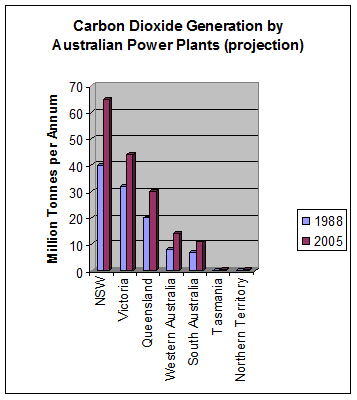Sources of Carbon Dioxide
At the present time, carbon dioxide is dumped into the atmosphere from power stations, industrial plant, vehicles and domestic heating, just as we might dump sewage into the ocean. Up until recently this has caused very little impact on the global environment. This is because carbon dioxide is a natural part of the planetary carbon cycle and because coal, oil and gas are carbon dioxide extracted from the air or sea and fixed by past plant or animal life.
Coal, gas and oil represent only a small fraction of the total carbon resources of the planet. Most of the carbon resources are held in the ocean and in minerals. The eco-system of the planet is constantly absorbing and emitting carbon dioxide. Atmospheric carbon dioxide provides the basis for plant growth. The sun provides the energy used by plants to absorb carbon dioxide and this energy is released to fuel the cell activity of plants and animals that consume the plants. Some of this biomass (timber, straw etc) can also be burnt to release the stored energy. Any remainder can become compacted and eventually converts, typically to coal.
Burning previously fixed carbon dioxide (coal, oil, gas and timber) can upset the delicate equilibrium established in the carbon cycle of the planet.
Because carbon dioxide forms a very small fraction of the atmosphere, a relatively small amount resulting from the burning of fossil fuels represents a large percentage increase and can have an impact on the relatively vast volume of the atmosphere surrounding the planet. This can in turn have a very significant effect on the rate of absorption of solar energy.
In the past twenty years, carbon dioxide in the earth's atmosphere has increased by about 9%. The principle cause of the recent rapid increase in carbon dioxide has been burning carbon-based materials for energy. These carbon-based materials, including coal, oil, gas and wood products, currently supply about 90% of the world's energy requirements.
The imbalance in carbon dioxide is being made worse by the removal of a large number of trees (which previously absorbed carbon dioxide) particularly in third world countries, and possibly by the pollution of lakes and oceans preventing the absorption of carbon dioxide by algae.
In NSW, power stations produce over 45 million tonnes of carbon dioxide a year. NSW has explored a number of alternative sources of electrical energy (including wind and solar). The Snowy Mountains scheme and all other non-coal sources together, contribute less than 10% of the State’s needs. The only known and presently practical alternative to coal is nuclear power, not a political possibility in NSW in the foreseeable future. At current growth rates, NSW power stations are projected to produce over 80 million tonnes of carbon dioxide per year by 2010.

Coal burning power stations are only one source of carbon dioxide. Petroleum fuelled vehicles not only produce huge volumes carbon of dioxide (over 2 kg for every litre used) but also other gasses and particulates that pollute our cities.
Metals smelting (iron and steel, aluminium, copper etc) glass making and other materials using high temperature processes are also significant, particularly when carbon is used both for energy and to reduce metallic ores. In the case of aluminium for example, a combination of coal sourced electrical energy (35% thermal efficiency) and consumable carbon electrodes (obtained from petroleum coke at high-energy cost) is used to reduce alumina to aluminium metal. All these processes produce large quantities of CO2.
Another major source of carbon dioxide is cement manufacture from calcined limestone. In this process limestone is heated by coal or other fossil fuel and carbon dioxide released both from the fuel and the calcination. To produce one tonne of cement nearly two and a half tonnes of carbon dioxide are released. This figure does not include transport fuel. A major use of cement is in concrete. About one tonne of CO2 is released for every 5 tonnes of concrete. Thus each large building, road or concrete structure represents many thousands of tonnes of carbon dioxide released to the atmosphere[5].
